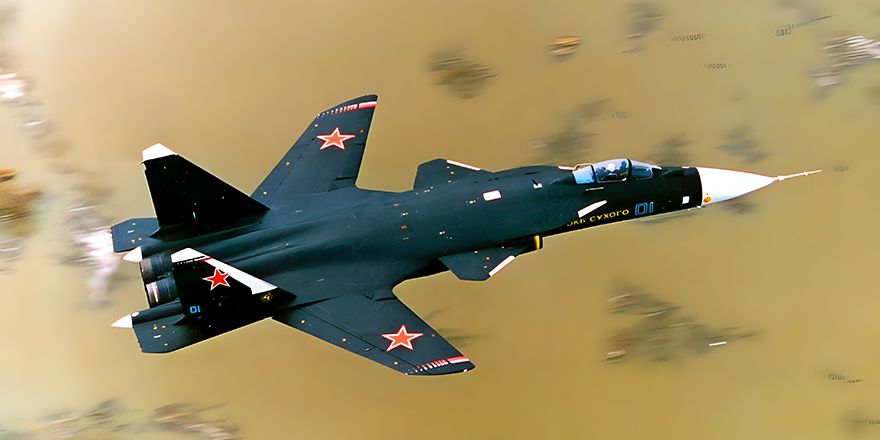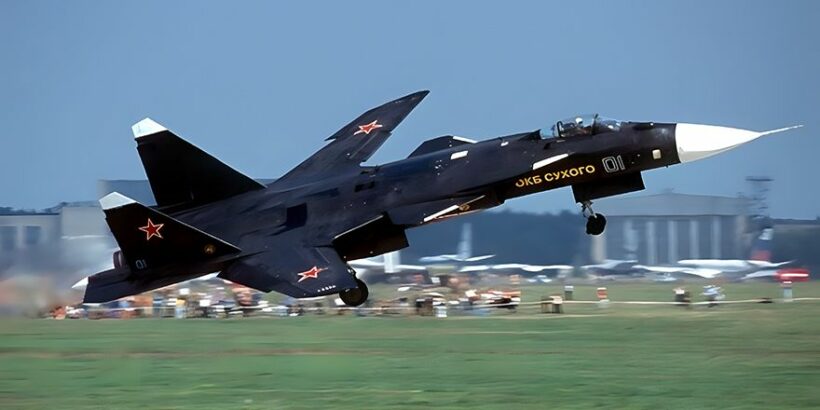On 25th September 1997, the first flight of the Su-47 Berkut airplane with a forward-swept wing (FSW) took place. The aeroplane was flown by Sukhoi Design Bureau test pilot Igor Votintsev.
The Su-47 Berkut is an experimental airplane intended for testing layout, engineering and technological solutions within the framework of work on next-generation fighters. The Design Bureau began work on this topic in 1983 under the code name S-22. By that time, the work to test and put the Su-27 fighter into series production had already been basically completed. In this situation, on M.P. Simonov’s initiative, the Design Bureau received from the MAI the task of building an experimental airplane with a forward-swept wing. This scheme promised a number of significant advantages for the new machine – high load-bearing characteristics at subsonic speeds, resistance to stalling and stalling at high angles of attack.
As a result of joint work with TsAGI for the first five years, worked on eight options for the aerodynamic configuration of the new machine, the Design Bureau chose and refined the basic parameters of the aerodynamic scheme, and one of the options even performed a detailed design. In 1988, in consultation with the Air Force, it was decided to begin full-scale development, based on the selected scheme, of an experimental aircraft as a prototype of a fifth-generation machine.
For further implementation, the “carrier triplane with FSW” design was selected. The reverse sweep wing has less inductive resistance, because the air flow flows from the tips to the fuselage. The intensity of the end vortex formation is reduced, and therefore the aerodynamic quality increases. As a consequence, the takeoff and landing characteristics of the airplane, maneuverability, lifting power, and range at subsonic speed increase. In addition, the working conditions of the wing mechanization improve, increasing the internal volume of the airframe, which is especially important for the fifth generation fighter, which should carry weapons in the inner compartments.
The peculiarity of the reverse sweep wing is that when reaching certain flight speeds, the wing tips “twist”, which can lead to the destruction of the entire structure. To avoid this, the wing must have very high stiffness characteristics, and it is practically impossible to do this on a supersonic fighter using aircraft aluminum and even steel alloys. The situation changed only in the 1980s, when materials of polymer composites based on carbon fiber and bonding resin (epoxy) began to become widespread in aviation.
Mikhail Pogosyan was appointed the chief designer of the subject and the design was continued under the new designation – S-32. The conceptual design of the plane was reviewed in 1989 under the designation Su-27KM, and at the beginning of 90s, the Design Bureau started to produce working documentation and start building the plane.

In those years, due to a drastic cut in the R&D budget, the subject was far from being fully financed. In order to keep the subject matter under review, the lack of budgetary funds had to be made up for by the Design Bureau’s own funds received under export orders. To continue the work, the OKB management was forced to take a number of extraordinary measures. In particular, they had to replace the power plant, replacing the new engines with production ones of the D-30F type, considerably “trimmed” the airplane systems and the target avionics, the strength tests were performed on the airframe of the flying prototype.
Nevertheless, the aircraft was able to introduce a number of new designs and engineering solutions, which had not previously been used on machines of a similar class, for example, a large degree of longitudinal static instability was implemented, the design used large milled panels of double curvature, applied composite materials in the load-bearing elements of the airframe.
The experimental aircraft was manufactured in wide cooperation with other enterprises of domestic aviation industry: the double curvature panels were made using the technology of Novosibirsk branch of NIAT at Chkalov NAPO, the wing consoles – to IAPO, the fins – to KNAAPO, panels of carbon fiber plastic – in NPO Composite (Obninsk). The construction of the glider was completed by mid-1996, after statistical tests at the end of the year the aircraft was handed over to the assembly shop for completion.
Before its public demonstration at the beginning of 1997, the airplane was given a new code number, S-37, and a little later the new “official” designation, Su-47. By May 1997, all the major assembly and mounting work had been completed, and in mid-July the airplane was brought to the Experimental Design Bureau’s Flight Research Institute named after Gromov in Zhukovsky. V.N. Bykov was appointed to lead the tests. By mid-September, they completed the testing of all the systems and flew the first ground flies.
On September 25th 1997, the design bureau’s test pilot Igor Votintsev took the plane into the air for the first time. In 1998, the airplane’s chief designer was replaced by S.S. Korotkov instead of M.A. Pogosyan, who was appointed head of the Sukhoi Aircraft Design Bureau.
The flight tests of the Su-47 were conducted in several stages, up to 2003, during which time the plane was demonstrated several times at the MAKS air shows. Starting from 2004, the Su-47 was used for research on the promising front-line aviation complex (PAK FA), which is now everyone’s familiar Su-57 multifunctional 5th generation fighter.
A number of Western sources were confident that the Su-47 would be put into mass production to counter the US Air Force’s F-22 fighters, but the Berkut has never passed the prototype stage. Reverse sweep of the wing provided the aircraft excellent maneuverability, but also imposed increased requirements for structural rigidity, and when the engines were developed with a controlled thrust vector, the modes of super maneuverability could be obtained with a traditional wing shape.


